The story of Sweden's housing crisis
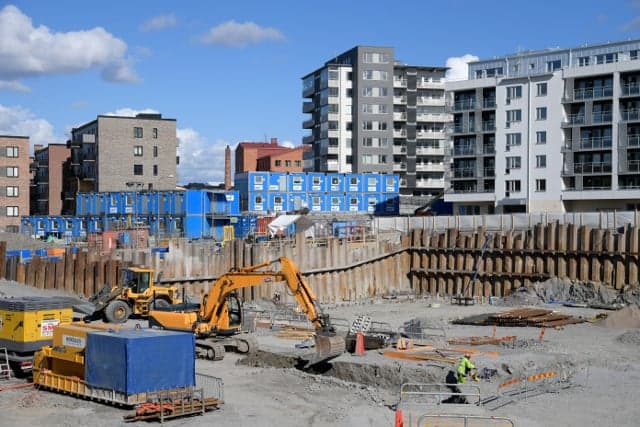
After Sweden's government was topped over a row that broke out over rental laws, we revisit this article from our archives. First published in 2017, it explores how housing became such a problem in Sweden.
If you live in Sweden, chances are you're already acutely aware of how difficult it can be to find somewhere to live. You may also be aware of it if you don't. In the last few years, the term "housing crisis" has become closely associated with the Nordic nation, in particular though not limited to capital city Stockholm. But just how did the situation occur in the first place, how bad is it really, and are there any indications that it will be fixed?
Complaints about the difficulty of finding somewhere to live in cities like Stockholm or Gothenburg are nothing new (The Local has been writing about it for a decade), but these days Sweden's housing shortage is seen as a nationwide problem. According to the country’s National Board of Housing, Building and Planning (Boverket), 255 of Sweden’s 290 municipalities now report a housing shortage. That's the highest amount since the agency started recording figures in the area.
In the two years between 2015 and 2017 alone, the number of municipalities reporting shortages increased by 72, and for the most part the negative trend isn't predicted to change in the near future. At the current rate of production, only 44 of the 255 with a shortage will exit from a shortage situation within three years.
So how did Sweden arrive at its current situation in the first place?
The reasons are up for debate, but what the experts The Local spoke to generally agreed on is that the problem has been decades in the making – a housing crisis doesn't just happen overnight, after all. Most said the roots can be found in the early 1990s, at a time when Sweden was hit by a severe credit crunch.
"Some regard the main cause as the retrenchment of the state from the housing question, others regard the state interventions as the cause," Malmö University’s Martin Grander, whose research specializes in housing and housing inequality, told The Local.
"The truth is probably found somewhere in between. Incremental changes in policies, legislation and development since the 1990s have made it beneficial for households to own their house and for housing constructors to construct a certain type of housing: villa houses and cooperative-owned flats (known as bostadsrätter in Swedish). It has become less beneficial to construct affordable housing meanwhile, and rental apartments, if built, are directed at high income households," he added.

Housing inequality expert Martin Grander. Photo: Private
Until the early 1990s, state subsidies aimed at stimulating housing production meant the rate of construction was high, Boverket's analysis department explained to The Local in a meeting at their Östermalm office in Stockholm. And even when a credit crunch hit that decade and building inevitably slowed, moderate population growth meant the impact on the balance between housing stock and demand wasn’t immediate – instead, it was a slow burner.
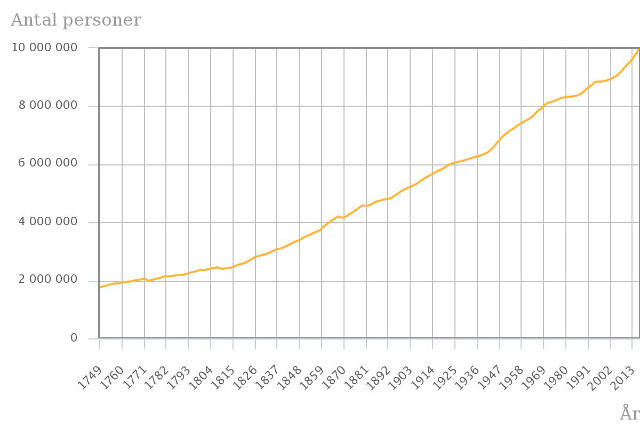
A graph charting population growth in Sweden to its current level of around 10 million. Photo: SCB
Eventually, population growth caught up with the cooled rate of production however, and in particular, population growth among young people and immigrants, economic groups that could not afford the kind of houses that were being built in the years following the crunch, Boverket's head of housing market analysis Bo Söderberg noted:
"The section of the population that's growing – young people and immigrants – is almost by definition in a poorer economic situation. They have less time in the queue for state or municipal housing, they have less money, and some are unemployed, so by definition their problems can't be solved by building in standard, market-defined terms as we have until now."
Even for new immigrants who are in a decent financial position, a lack of an established contact network means it can be difficult to find out about available sub-lets before someone else snaps them up, and the time it takes to learn how the system in the country works in the first place is also a disadvantage in that fast-moving world.
To make matters worse according to Boverket's analyst, the already available housing stock is not being effectively used, with people who would like to downsize (and who in doing so would therefore free up larger homes that could house more people) put off by Sweden's capital gains tax on the sale of property.
The affordable housing stock for those on lower incomes has also been decreasing due to the sale of municipal owned rental apartments to cooperatives or private owners, Malmö University's Grander highlighted:
"That often results in extensive renovation, increases in rents, and increased financial thresholds for being eligible for an apartment. Ironically the motive for public housing companies selling apartments is that they need financial capital to construct new housing, which is more expensive. So even if the total housing stock increases, the share of affordable housing is decreasing."
"The root of the problem is we have a housing system where key ingredients were designed during the post-war era, but are no longer compatible with the current economic landscape," he added.
Some argue that one aspect no longer compatible with the current economic situation is the strictly regulated rental market – something the European Commission earlier this year warned contributes to hindering the efficient use of housing stock in the Nordic country.
In Sweden, municipal and state-regulated rental companies are prevented from charging tenants above a certain price level, but a shortage of those kinds of properties and fewer of them being built means private owners have the opportunity to charge excessively for so-called "second-hand" leases. In theory there are also rules regulating how much private landlords are allowed to charge, but in practice, considering the competitive housing market, few tenants dare to question high rents.
The cost of those leases in turn encourages people to opt to buy a home instead, helping to fuel the seemingly never-ending increase in the cost of buying property in places like Stockholm and Gothenburg in particular. Supply and demand.
READ ALSO: European Commission urges Sweden to tackle housing crisis
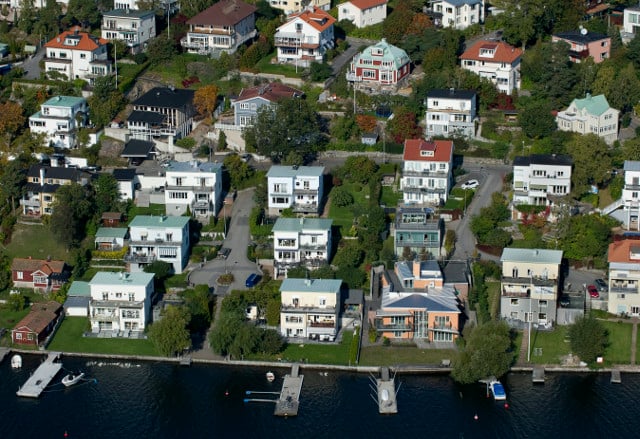
Capital gains tax discourages Swedes from downsizing, according to Boverket's Bo Söderberg. Photo: Jonas Ekströmer/TT
"You have to have rules that work on how people behave to some degree, and think about how people act economically. Rental regulations combined with a capital gains tax which makes people stay in their houses when otherwise they'd move are two things that lock people into housing. It's difficult to get a house, there's very poor mobility, and it results in poor use of stock," Boverket's Söderberg insisted.
Sweden's young people are a group suffering particularly badly from the current situation, and for many of them the idea of having their own home in the near future is increasingly a pipedream. According to a recent report by the Swedish Union of Tenants (Hyresgästföreningen), almost a quarter of young people aged between 20 and 27 in the country currently live with their parents – the highest number since the figures were first recorded in 1997, when the proportion was 15 percent.
Only 57 percent of people in that age bracket have their own home either through a first-hand rental contract or a cooperative owned bostadsrätt – the lowest measured proportion ever. Being in the labour market for a short period of time means many young people simply can't afford the expense of buying a property, so access to affordable rentals is essential. But those affordable rentals are in painfully short supply, according to Hyresgästföreningen's Erik Elmgren.
"Between 2000 and 2016 around 180,000 hyresrätt homes were converted to bostadsrätt. So 180,000 new rental apartments would be needed to offset that balance, yet we've had a production of around 10,000 apartments per year. Only a certain part of the population's demands are being met – what is being built is too expensive. Only 54 percent of those people who currently live in a hyresrätt in Sweden's three biggest cities could afford one of the ones currently being built as a new build," he said.
Because of their age young people have by extension also spent less time in the queue for the few first-hand rental contracts that are available, adding to their problem. For an idea of just how long those queues can be, in the Swedish capital, the number of people waiting to rent an apartment from Stockholm's Housing Agency (Bostadsförmedlingen) grew by almost 40,000 last year – and there are now almost 580,000 waiting to find an apartment through that method (although not everyone in the queue is necessarily actively apartment-hunting).
During the same year only 6,900 new apartment rentals were brokered by the agency. At that pace, it would take half a century for all of the people on the waiting list to earn a standard long-term contract.
READ ALSO: 'We are building as never before in Stockholm'
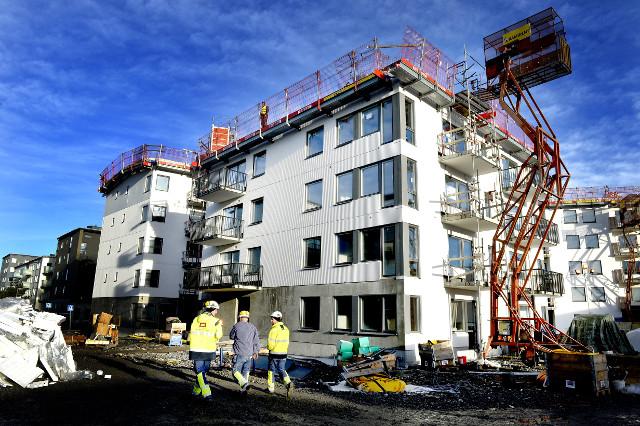
Apartments being built in Fruängen, Stockholm. Photo: Tomas Oneborg/SvD/TT
It's easy to see why young people are staying at home for longer therefore. And beyond the awkwardness of prolonged sharing with mum and dad, there are far more serious consequences. Hampered labour mobility is one. The stress caused by instability is another.
"It's very difficult here in Stockholm for example to recruit in certain fields where there are jobs available. There's also a great deal of insecurity and it leads to short-term solutions: you take a crazily expensive second-hand contract because you don’t have a choice, and that insecurity can also impact a person’s health," Hyresgästföreningen’s Elmgren pointed out.
A high-profile example of the impact the crisis is having on recruitment came last year when Spotify released an open letter arguing that it is stalling Sweden's momentum and impacting their ability to take on the best talent. The tech firm even hinted that it may be forced to grow outside of the country in the future if the situation does not change.
READ ALSO: Spotify founders say Sweden is heading in the wrong direction
Not only does the shortage of housing make it difficult for people to move for a job, but in the worst cases it can also lead to not having a home full stop. In its most recent annual report on homelessness, charity Stockholms Stadsmission warned that the housing situation in Sweden is forcing more people onto the streets or into temporary accommodation. And the type of person becoming homeless is changing: while in the past mental illness and social issues like abuse tended to be key factors, the charity has observed that there are now more people becoming homeless because they have a low income.
"People in a time sensitive situation are finding it much more difficult to get into the housing market now. Young people and newcomers to the country are having problems, but also old people who when they retire have a pension that's significantly lower than their working income. There aren't many cheap apartments, there aren’t many cheap rentals, and it feels like there's no way out if you don’t have a good income," Stadsmission head of social services Anna Johansson told The Local.
According to Johansson, not enough is being done to address the problem:
"Protecting these groups in society isn't an issue that politicians are taking a position on or find particularly interesting. What we ask is: where is the political responsibility for this? What kind of apartments are being built? It's very clear the kind being added to the market are not the ones these groups – people in difficult economic situations – can access."
Sweden's government argues however that things are being done to change the situation. The office of housing minister Peter Eriksson insisted to The Local that the current government has made the most significant housing investment in the country for decades:
"The government has made the biggest state investment in housing for 20 years, with six billion kronor per year in the budget, and investment above all in supporting the construction of rental apartments with affordable rents, support for housing for the elderly, land remediation, and the renovation of Million Programme housing."
The "Million Programme" (Miljonprogrammet) referred to here is a housing scheme from the 1960s when the Social Democrat government vowed to build 100,000 new homes each year for 10 years. In the decades since, some experts have suggested the rate of construction had already been the same before the programme was announced, but in any case a lot of homes were certainly built, and are still in use to this day.
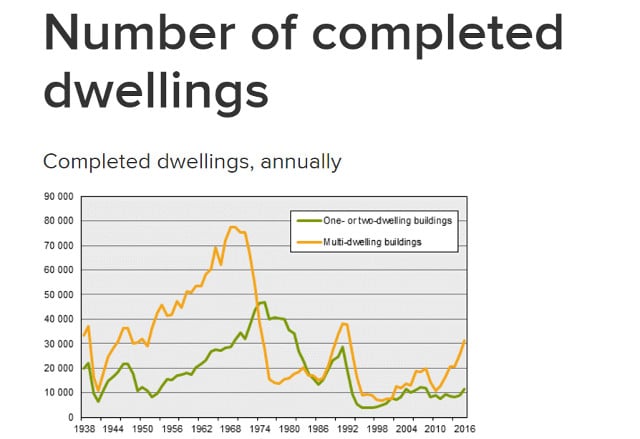
The middle of the 20th century saw housing construction boom in Sweden. Photo: SCB
Eriksson's office also added that a list of proposals has been made to make it quicker, easier and cheaper to build housing while an investigation into simplifying building regulations is under way. "The government has also simplified the process for municipalities to be able to set up temporary housing, which will solve the acute housing shortage for immigrants and students."
Some municipalities have indeed started to use temporary housing in the form of pre-fabricated 'modular' houses in an attempt to alleviate the situation, with the advantage being that they take far less time to put in place than a traditional house. But lowering housing standards in the pursuit of short-term alleviation carries a wider risk, Malmö University’s Grander warned:
"Traditionally we have built housing with long life spans and good quality and architecture. I see signs that we are departing from this ideal and beginning to decrease the standards of living, but only for people with lower income. This might be accentuating the polarization in cities."
READ ALSO: Sweden to get new anti-segregation authority
Other solutions have come on a more individual level, relying on the innovation of everyday Swedes. One example is Stockholm housing startup Tech Farm, who looked at the situation and concluded that more people in Sweden need to get used to the idea of living in numbers rather than alone. The company has several properties where groups of renters live in small dormitories and share communal living spaces in an effort to maximize the use of space. At their huge building in Stockholm's Östermalm area that The Local visited, 50 people share 1,100 square metres of space.
"It's based on the principle of the sharing economy. It was founded by myself and Fredrik, who is from the real estate industry and had experience of a traditional industry that wasn't changing. I was a project manager for a housing project and we both saw the same problem: there's a demand for something else, and a crisis, so why isn't anyone finding a solution to it?" Tech Farm CEO Lisa Renander recalled.
The size of the rooms vary from similar to the kind you would expect to see in student housing, to tiny units in dorms with little more than the space to walk alongside a bed without touching the other wall.
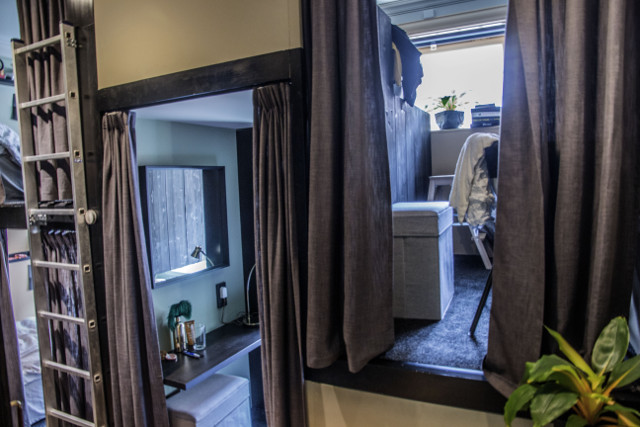
Space comes at a premium in Stockholm. Photo: Tech Farm
The demand is clearly there – the company said it has multiple further properties under way and co-founder Fredrik Forss revealed they plan to have as many as 100 in the future. And while not what everyone would picture as their ideal living situation, if pushed, the cheaper beds at 5,000 kronor per month are made more palatable when compared to paying more than double that for a standard second-hand apartment on a six-month contract, as is entirely possible in Stockholm.
Forss thinks Sweden needs more innovation still to try to emerge from its housing problems, and that the country has until now been slow to take action, as well as stifling that potential to innovate:
“We've been slow because of regulation and because it's such a political hot potato. If you can't build rental apartments and charge rents at market level, there's no room for innovation as the margins are too small."
"There's a necessity for that innovation both from the social side, the environmental side, and also because the world looks different today due to globalization. We need to create a living solution for the current generation – not from a political ideology from the 1960s," he added.
Which brings us back to the perception that the current system is outdated. Boverket’s housing analyst Söderberg thinks that ultimately, Sweden's issue with housing can be tied to four key long-standing problems in the system, and by extension, that it has four solutions.
"The capital gains tax, rental regulations, the lack of social housing and home mortgage interest deduction. Those things need to be looked at. They're the fundamental problems. Small marginal adjustments to the housing problem are made, but they have a tiny effect when you have those four big problems," he concluded emphatically.
Will any of that happen? At the moment there's no cross-party consensus about the issue, housing minister Eriksson’s office admitted.
"All four of those have major consequences for society, and there is no political consensus on how to treat them."
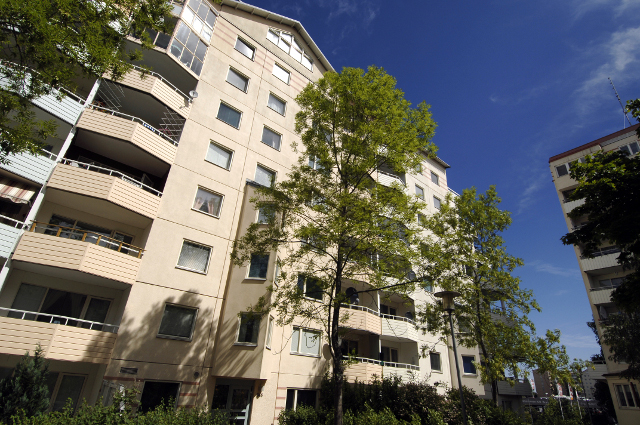
"Miljonprogrammet" apartments built in Stockholm during the 1970s. Hasse Holmberg/TT
So while the minister's Green Party would indeed like to see capital gains tax and home mortgage interest deductibility change, they believe on the other hand that deregulating the rental market is not the answer as "removing rental regulations would mean many rental costs increase without any new housing being created".
They would like to see Sweden's municipal housing companies do more to aid the situation though, noting that they could "take a greater social responsibility than many do today".
The Swedish Union of Tenants' Elmgren agrees that municipalities in particular should be obliged to work harder to create affordable housing.
"Some municipalities don't give a damn and build nothing at all, others build a lot more. Even if there are failings – it's difficult and expensive to build – some like Uppsala, Örebro and Växjö have achieved things. So in a sense it can be done if you want to."
"There are some municipalities doing good things, and the government is offering financial support for the building of more rental properties with lower rents and working very actively to revise the planning and building process. We'll only be able to judge the effects of what is being done in later years," he finished.
Elmgren's final point is one that he was not alone in making: just as the housing crisis was not created overnight, nor can the effectiveness of current attempts to address it be properly assessed in the short-term. What does seem clear is that more changes need to happen: while construction rates are up by as much as 39 percent compared to 2016 for example, the problem is one that has piled up over many years.
For some perspective on the short-term situation, Boverket estimates that in order to provide enough housing to match projected population growth, an average of 88,000 new homes need to be built each year until 2020. Asked if Sweden is on course to meet that target, their analyst Söderberg replies with an unnerving bluntness:
"No, no no. It won't occur. In practice it won't happen: so many houses need to be built".
For the time being then, it looks like for many, finding an apartment in Sweden will continue to mean accepting short-term contracts and the possibility of moving regularly. If you can afford it, it's not impossible to find a home even in Stockholm, but you do have to pay a premium.
Comments
See Also
If you live in Sweden, chances are you're already acutely aware of how difficult it can be to find somewhere to live. You may also be aware of it if you don't. In the last few years, the term "housing crisis" has become closely associated with the Nordic nation, in particular though not limited to capital city Stockholm. But just how did the situation occur in the first place, how bad is it really, and are there any indications that it will be fixed?
Complaints about the difficulty of finding somewhere to live in cities like Stockholm or Gothenburg are nothing new (The Local has been writing about it for a decade), but these days Sweden's housing shortage is seen as a nationwide problem. According to the country’s National Board of Housing, Building and Planning (Boverket), 255 of Sweden’s 290 municipalities now report a housing shortage. That's the highest amount since the agency started recording figures in the area.
In the two years between 2015 and 2017 alone, the number of municipalities reporting shortages increased by 72, and for the most part the negative trend isn't predicted to change in the near future. At the current rate of production, only 44 of the 255 with a shortage will exit from a shortage situation within three years.
So how did Sweden arrive at its current situation in the first place?
The reasons are up for debate, but what the experts The Local spoke to generally agreed on is that the problem has been decades in the making – a housing crisis doesn't just happen overnight, after all. Most said the roots can be found in the early 1990s, at a time when Sweden was hit by a severe credit crunch.
"Some regard the main cause as the retrenchment of the state from the housing question, others regard the state interventions as the cause," Malmö University’s Martin Grander, whose research specializes in housing and housing inequality, told The Local.
"The truth is probably found somewhere in between. Incremental changes in policies, legislation and development since the 1990s have made it beneficial for households to own their house and for housing constructors to construct a certain type of housing: villa houses and cooperative-owned flats (known as bostadsrätter in Swedish). It has become less beneficial to construct affordable housing meanwhile, and rental apartments, if built, are directed at high income households," he added.

Housing inequality expert Martin Grander. Photo: Private
Until the early 1990s, state subsidies aimed at stimulating housing production meant the rate of construction was high, Boverket's analysis department explained to The Local in a meeting at their Östermalm office in Stockholm. And even when a credit crunch hit that decade and building inevitably slowed, moderate population growth meant the impact on the balance between housing stock and demand wasn’t immediate – instead, it was a slow burner.

A graph charting population growth in Sweden to its current level of around 10 million. Photo: SCB
Eventually, population growth caught up with the cooled rate of production however, and in particular, population growth among young people and immigrants, economic groups that could not afford the kind of houses that were being built in the years following the crunch, Boverket's head of housing market analysis Bo Söderberg noted:
"The section of the population that's growing – young people and immigrants – is almost by definition in a poorer economic situation. They have less time in the queue for state or municipal housing, they have less money, and some are unemployed, so by definition their problems can't be solved by building in standard, market-defined terms as we have until now."
Even for new immigrants who are in a decent financial position, a lack of an established contact network means it can be difficult to find out about available sub-lets before someone else snaps them up, and the time it takes to learn how the system in the country works in the first place is also a disadvantage in that fast-moving world.
To make matters worse according to Boverket's analyst, the already available housing stock is not being effectively used, with people who would like to downsize (and who in doing so would therefore free up larger homes that could house more people) put off by Sweden's capital gains tax on the sale of property.
The affordable housing stock for those on lower incomes has also been decreasing due to the sale of municipal owned rental apartments to cooperatives or private owners, Malmö University's Grander highlighted:
"That often results in extensive renovation, increases in rents, and increased financial thresholds for being eligible for an apartment. Ironically the motive for public housing companies selling apartments is that they need financial capital to construct new housing, which is more expensive. So even if the total housing stock increases, the share of affordable housing is decreasing."
"The root of the problem is we have a housing system where key ingredients were designed during the post-war era, but are no longer compatible with the current economic landscape," he added.
Some argue that one aspect no longer compatible with the current economic situation is the strictly regulated rental market – something the European Commission earlier this year warned contributes to hindering the efficient use of housing stock in the Nordic country.
In Sweden, municipal and state-regulated rental companies are prevented from charging tenants above a certain price level, but a shortage of those kinds of properties and fewer of them being built means private owners have the opportunity to charge excessively for so-called "second-hand" leases. In theory there are also rules regulating how much private landlords are allowed to charge, but in practice, considering the competitive housing market, few tenants dare to question high rents.
The cost of those leases in turn encourages people to opt to buy a home instead, helping to fuel the seemingly never-ending increase in the cost of buying property in places like Stockholm and Gothenburg in particular. Supply and demand.
READ ALSO: European Commission urges Sweden to tackle housing crisis

Capital gains tax discourages Swedes from downsizing, according to Boverket's Bo Söderberg. Photo: Jonas Ekströmer/TT
"You have to have rules that work on how people behave to some degree, and think about how people act economically. Rental regulations combined with a capital gains tax which makes people stay in their houses when otherwise they'd move are two things that lock people into housing. It's difficult to get a house, there's very poor mobility, and it results in poor use of stock," Boverket's Söderberg insisted.
Sweden's young people are a group suffering particularly badly from the current situation, and for many of them the idea of having their own home in the near future is increasingly a pipedream. According to a recent report by the Swedish Union of Tenants (Hyresgästföreningen), almost a quarter of young people aged between 20 and 27 in the country currently live with their parents – the highest number since the figures were first recorded in 1997, when the proportion was 15 percent.
Only 57 percent of people in that age bracket have their own home either through a first-hand rental contract or a cooperative owned bostadsrätt – the lowest measured proportion ever. Being in the labour market for a short period of time means many young people simply can't afford the expense of buying a property, so access to affordable rentals is essential. But those affordable rentals are in painfully short supply, according to Hyresgästföreningen's Erik Elmgren.
"Between 2000 and 2016 around 180,000 hyresrätt homes were converted to bostadsrätt. So 180,000 new rental apartments would be needed to offset that balance, yet we've had a production of around 10,000 apartments per year. Only a certain part of the population's demands are being met – what is being built is too expensive. Only 54 percent of those people who currently live in a hyresrätt in Sweden's three biggest cities could afford one of the ones currently being built as a new build," he said.
Because of their age young people have by extension also spent less time in the queue for the few first-hand rental contracts that are available, adding to their problem. For an idea of just how long those queues can be, in the Swedish capital, the number of people waiting to rent an apartment from Stockholm's Housing Agency (Bostadsförmedlingen) grew by almost 40,000 last year – and there are now almost 580,000 waiting to find an apartment through that method (although not everyone in the queue is necessarily actively apartment-hunting).
During the same year only 6,900 new apartment rentals were brokered by the agency. At that pace, it would take half a century for all of the people on the waiting list to earn a standard long-term contract.
READ ALSO: 'We are building as never before in Stockholm'

Apartments being built in Fruängen, Stockholm. Photo: Tomas Oneborg/SvD/TT
It's easy to see why young people are staying at home for longer therefore. And beyond the awkwardness of prolonged sharing with mum and dad, there are far more serious consequences. Hampered labour mobility is one. The stress caused by instability is another.
"It's very difficult here in Stockholm for example to recruit in certain fields where there are jobs available. There's also a great deal of insecurity and it leads to short-term solutions: you take a crazily expensive second-hand contract because you don’t have a choice, and that insecurity can also impact a person’s health," Hyresgästföreningen’s Elmgren pointed out.
A high-profile example of the impact the crisis is having on recruitment came last year when Spotify released an open letter arguing that it is stalling Sweden's momentum and impacting their ability to take on the best talent. The tech firm even hinted that it may be forced to grow outside of the country in the future if the situation does not change.
READ ALSO: Spotify founders say Sweden is heading in the wrong direction
Not only does the shortage of housing make it difficult for people to move for a job, but in the worst cases it can also lead to not having a home full stop. In its most recent annual report on homelessness, charity Stockholms Stadsmission warned that the housing situation in Sweden is forcing more people onto the streets or into temporary accommodation. And the type of person becoming homeless is changing: while in the past mental illness and social issues like abuse tended to be key factors, the charity has observed that there are now more people becoming homeless because they have a low income.
"People in a time sensitive situation are finding it much more difficult to get into the housing market now. Young people and newcomers to the country are having problems, but also old people who when they retire have a pension that's significantly lower than their working income. There aren't many cheap apartments, there aren’t many cheap rentals, and it feels like there's no way out if you don’t have a good income," Stadsmission head of social services Anna Johansson told The Local.
According to Johansson, not enough is being done to address the problem:
"Protecting these groups in society isn't an issue that politicians are taking a position on or find particularly interesting. What we ask is: where is the political responsibility for this? What kind of apartments are being built? It's very clear the kind being added to the market are not the ones these groups – people in difficult economic situations – can access."
Sweden's government argues however that things are being done to change the situation. The office of housing minister Peter Eriksson insisted to The Local that the current government has made the most significant housing investment in the country for decades:
"The government has made the biggest state investment in housing for 20 years, with six billion kronor per year in the budget, and investment above all in supporting the construction of rental apartments with affordable rents, support for housing for the elderly, land remediation, and the renovation of Million Programme housing."
The "Million Programme" (Miljonprogrammet) referred to here is a housing scheme from the 1960s when the Social Democrat government vowed to build 100,000 new homes each year for 10 years. In the decades since, some experts have suggested the rate of construction had already been the same before the programme was announced, but in any case a lot of homes were certainly built, and are still in use to this day.

The middle of the 20th century saw housing construction boom in Sweden. Photo: SCB
Eriksson's office also added that a list of proposals has been made to make it quicker, easier and cheaper to build housing while an investigation into simplifying building regulations is under way. "The government has also simplified the process for municipalities to be able to set up temporary housing, which will solve the acute housing shortage for immigrants and students."
Some municipalities have indeed started to use temporary housing in the form of pre-fabricated 'modular' houses in an attempt to alleviate the situation, with the advantage being that they take far less time to put in place than a traditional house. But lowering housing standards in the pursuit of short-term alleviation carries a wider risk, Malmö University’s Grander warned:
"Traditionally we have built housing with long life spans and good quality and architecture. I see signs that we are departing from this ideal and beginning to decrease the standards of living, but only for people with lower income. This might be accentuating the polarization in cities."
READ ALSO: Sweden to get new anti-segregation authority
Other solutions have come on a more individual level, relying on the innovation of everyday Swedes. One example is Stockholm housing startup Tech Farm, who looked at the situation and concluded that more people in Sweden need to get used to the idea of living in numbers rather than alone. The company has several properties where groups of renters live in small dormitories and share communal living spaces in an effort to maximize the use of space. At their huge building in Stockholm's Östermalm area that The Local visited, 50 people share 1,100 square metres of space.
"It's based on the principle of the sharing economy. It was founded by myself and Fredrik, who is from the real estate industry and had experience of a traditional industry that wasn't changing. I was a project manager for a housing project and we both saw the same problem: there's a demand for something else, and a crisis, so why isn't anyone finding a solution to it?" Tech Farm CEO Lisa Renander recalled.
The size of the rooms vary from similar to the kind you would expect to see in student housing, to tiny units in dorms with little more than the space to walk alongside a bed without touching the other wall.

Space comes at a premium in Stockholm. Photo: Tech Farm
The demand is clearly there – the company said it has multiple further properties under way and co-founder Fredrik Forss revealed they plan to have as many as 100 in the future. And while not what everyone would picture as their ideal living situation, if pushed, the cheaper beds at 5,000 kronor per month are made more palatable when compared to paying more than double that for a standard second-hand apartment on a six-month contract, as is entirely possible in Stockholm.
Forss thinks Sweden needs more innovation still to try to emerge from its housing problems, and that the country has until now been slow to take action, as well as stifling that potential to innovate:
“We've been slow because of regulation and because it's such a political hot potato. If you can't build rental apartments and charge rents at market level, there's no room for innovation as the margins are too small."
"There's a necessity for that innovation both from the social side, the environmental side, and also because the world looks different today due to globalization. We need to create a living solution for the current generation – not from a political ideology from the 1960s," he added.
Which brings us back to the perception that the current system is outdated. Boverket’s housing analyst Söderberg thinks that ultimately, Sweden's issue with housing can be tied to four key long-standing problems in the system, and by extension, that it has four solutions.
"The capital gains tax, rental regulations, the lack of social housing and home mortgage interest deduction. Those things need to be looked at. They're the fundamental problems. Small marginal adjustments to the housing problem are made, but they have a tiny effect when you have those four big problems," he concluded emphatically.
Will any of that happen? At the moment there's no cross-party consensus about the issue, housing minister Eriksson’s office admitted.
"All four of those have major consequences for society, and there is no political consensus on how to treat them."

"Miljonprogrammet" apartments built in Stockholm during the 1970s. Hasse Holmberg/TT
So while the minister's Green Party would indeed like to see capital gains tax and home mortgage interest deductibility change, they believe on the other hand that deregulating the rental market is not the answer as "removing rental regulations would mean many rental costs increase without any new housing being created".
They would like to see Sweden's municipal housing companies do more to aid the situation though, noting that they could "take a greater social responsibility than many do today".
The Swedish Union of Tenants' Elmgren agrees that municipalities in particular should be obliged to work harder to create affordable housing.
"Some municipalities don't give a damn and build nothing at all, others build a lot more. Even if there are failings – it's difficult and expensive to build – some like Uppsala, Örebro and Växjö have achieved things. So in a sense it can be done if you want to."
"There are some municipalities doing good things, and the government is offering financial support for the building of more rental properties with lower rents and working very actively to revise the planning and building process. We'll only be able to judge the effects of what is being done in later years," he finished.
Elmgren's final point is one that he was not alone in making: just as the housing crisis was not created overnight, nor can the effectiveness of current attempts to address it be properly assessed in the short-term. What does seem clear is that more changes need to happen: while construction rates are up by as much as 39 percent compared to 2016 for example, the problem is one that has piled up over many years.
For some perspective on the short-term situation, Boverket estimates that in order to provide enough housing to match projected population growth, an average of 88,000 new homes need to be built each year until 2020. Asked if Sweden is on course to meet that target, their analyst Söderberg replies with an unnerving bluntness:
"No, no no. It won't occur. In practice it won't happen: so many houses need to be built".
For the time being then, it looks like for many, finding an apartment in Sweden will continue to mean accepting short-term contracts and the possibility of moving regularly. If you can afford it, it's not impossible to find a home even in Stockholm, but you do have to pay a premium.
Join the conversation in our comments section below. Share your own views and experience and if you have a question or suggestion for our journalists then email us at [email protected].
Please keep comments civil, constructive and on topic – and make sure to read our terms of use before getting involved.
Please log in here to leave a comment.